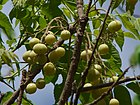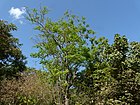Note: This is a project under development. The articles on this wiki are just being initiated and broadly incomplete. You can Help creating new pages.
Garuga pinnata
Garuga is a deciduous tree growing up to 18 metres tall, with bark pealing off in flakes. The tree is cultivated in home gardens in India for its edible fruit and also as a support for Piper nigrum.
Contents
- 1 Uses
- 2 Parts Used
- 3 Chemical Composition
- 4 Common names
- 5 Properties
- 6 Habit
- 7 Identification
- 8 List of Ayurvedic medicine in which the herb is used
- 9 Where to get the saplings
- 10 Mode of Propagation
- 11 Cultivation Details
- 12 Commonly seen growing in areas
- 13 Photo Gallery
- 14 References
- 15 External Links
Uses
[[:Category:Ayurvedic Herbs known to be helpful to treat |]], [[:Category:Ayurvedic Herbs known to be helpful to treat |]], [[:Category:Ayurvedic Herbs known to be helpful to treat |]], [[:Category:Ayurvedic Herbs known to be helpful to treat |]], [[:Category:Ayurvedic Herbs known to be helpful to treat |]], [[:Category:Ayurvedic Herbs known to be helpful to treat |]], [[:Category:Ayurvedic Herbs known to be helpful to treat |]], [[:Category:Ayurvedic Herbs known to be helpful to treat |]], [[:Category:Ayurvedic Herbs known to be helpful to treat |]], [[:Category:Ayurvedic Herbs known to be helpful to treat |]], [[:Category:Ayurvedic Herbs known to be helpful to treat |]].[1]
Food
Garuga pinnata can be used in Food. Mature fruits are eaten raw, cooked as a vegetable and pickled. They are acidic in taste[2].
Parts Used
Chemical Composition
Common names
| Language | Common name |
|---|---|
| Kannada | Aranelli |
| Hindi | Kharpat |
| Malayalam | Annakaara |
| Tamil | Arunelli |
| Telugu | Garuga |
| Marathi | Kakad |
| Gujarathi | Kaked |
| Punjabi | |
| Kashmiri | |
| Sanskrit | Karnikarha |
| English | Garuga, Grey downy balsam |
Properties
Reference: Dravya - Substance, Rasa - Taste, Guna - Qualities, Veerya - Potency, Vipaka - Post-digesion effect, Karma - Pharmacological activity, Prabhava - Therepeutics.
Dravya
Rasa
Guna
Veerya
Vipaka
Karma
Prabhava
Nutritional components
Garuga pinnata Contains the Following nutritional components like - Vitamin-C and E, Quercetin, Folic acid; Calcium, Iron, Magnesium Potassium, Phosphorus, Sodium[2].
Habit
Identification
Leaf
| Kind | Shape | Feature |
|---|---|---|
Flower
| Type | Size | Color and composition | Stamen | More information |
|---|---|---|---|---|
| {{{5}}} |
Fruit
| Type | Size | Mass | Appearance | Seeds | More information |
|---|---|---|---|---|---|
Other features
List of Ayurvedic medicine in which the herb is used
Where to get the saplings
Mode of Propagation
Cultivation Details
A plant of the moist tropics, where it is found at elevations from 400 - 1,200 metres[5]. Garuga pinnata is available through February to August[2].
Commonly seen growing in areas
Mixed forests, Sparse mountain forests, Valley scrub.
Photo Gallery
References
- ↑ Indian Medicinal Plants by C.P.Khare
- ↑ 2.0 2.1 2.2 "Forest food for Northern region of Western Ghats" by Dr. Mandar N. Datar and Dr. Anuradha S. Upadhye, Page No.83, Published by Maharashtra Association for the Cultivation of Science (MACS) Agharkar Research Institute, Gopal Ganesh Agarkar Road, Pune
- ↑ [Chemistry]
- ↑ [Morphology]
- ↑ Cultivation
External Links
- Ayurvedic Herbs known to be helpful to treat
- Herbs with Fruits used in medicine
- Herbs with common name in Kannada
- Herbs with common name in Hindi
- Herbs with common name in Malayalam
- Herbs with common name in Tamil
- Herbs with common name in Telugu
- Herbs with common name in Marathi
- Herbs with common name in Gujarathi
- Herbs with common name in Sanskrit
- Herbs with common name in English
- Habit - Deciduous tree
- Index of Plants which can be propagated by Seeds
- Index of Plants which can be propagated by Cuttings of roots
- Herbs that are commonly seen in the region of Mixed forests
- Herbs that are commonly seen in the region of Sparse mountain forests
- Herbs that are commonly seen in the region of Valley scrub
- Herbs
- Pages without herbs images




